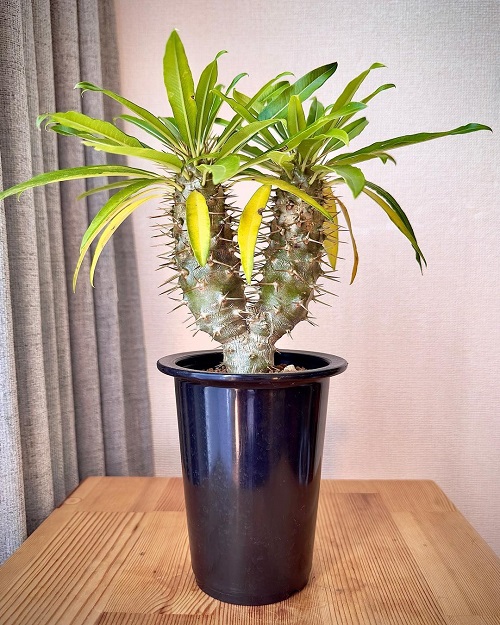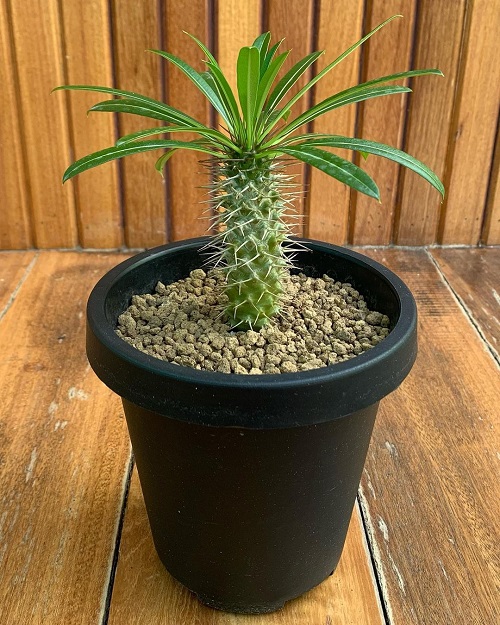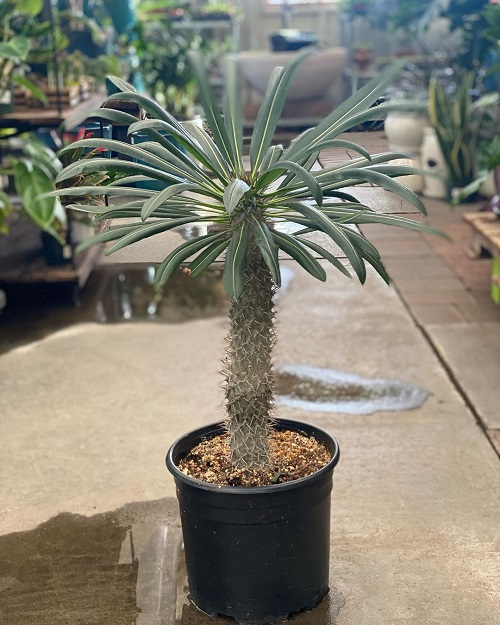With its unique bulbous trunk and lush foliage, and spiky appearance, Pachypodium lamerei will leave your guests envying plant collection!

Not a true palm, Madagascar Palm is a succulent that comes with the twist of a spiny trunk, giving your indoors a dramatic makeover. Being a succulent, needless to say, the Pachypodium lamerei doesn’t require a lot of care, just a little love, and it is good to go!
- Botanical Name: Pachypodium lamerei
- Common Name: Madagascar Palm, Madagascar Cactus Palm Tree, Pachypodium Species, Club Foot
- Features bulbous, spiky trunk crowned with yellow-green foliage
- Reaches a height handsome height of 3-6 feet indoors
- Loves bright light for the most part of the day
- Toxic to humans and pets if ingested
Pachypodium lamerei Plant Profile
With a strikingly unique appearance, Pachypodium lamerei stands at a height of 6 feet indoors in its mature years. The plant’s common name—Madagascar Palm, might trick you, but it is far from being a true palm. It is a shrub succulent with a thick and spiny gray-brown trunk that can store water for extended periods of time. The trunk is topped with a dense cluster of long, slender leaves that grow in a rosette pattern, giving the plant a distinctly tropical appearance.
The leathery, bright green foliage clubbed with the spiny trunk makes for a captivating display that is sure to draw the admiration of all who see it.
Ideal Pot Size
Get a pot that is one size bigger than the root ball of the plant. While starting out, get a small pot of 6-8 inches with ample drainage holes. However, if you want the plant to reach its glorious stature, transplant it to one size bigger container every time you see the roots coming out of the drainage holes.
Although Pachypodium lamerei is a succulent, it grows to a considerable height and will require 16-20 inch pot for mature size. In such a case, consider going with portable planters or keep a pot caddy handy, so you can move it around the house without throwing out your back!
Pachypodium lamerei Propagation

Pachypodium lamerei can be propagated through offset cuttings.
- Choose a healthy parent plant that has produced a few offsets or pups.
- Look for offsets that are at least 6 inches tall and have a few leaves. Carefully remove the offset from the parent plant using a sharp, sterilized knife or pruning shears.
- Make sure to cut as close to the parent stem as possible without damaging it. Remove any damaged or dead leaves from the offset, leaving a few intact.
- Fill a pot with a well-draining potting mix. Moisten the mix and make a small hole in the center, deep enough to accommodate the offset.
- Insert the base of the offset into the prepared hole and press the soil around it to ensure it is stable. Water the soil around the offset to settle it into the potting mix.
- Place the newly planted offset in a warm, bright spot where it will receive indirect sunlight.
Keep the soil moist but not overly wet, and avoid letting the soil dry out completely, either. After a few weeks, you should see new growth from the offset cutting. Keep an eye on it, and make sure to adjust the watering and lighting as needed to ensure it continues to grow strong and healthy.
Pro Tip: The plant takes its sweet time to grow, which can be anywhere between 3 weeks to six months. Getting a well-grown healthy plant from the nursery and nurturing it at home will save you time and effort.
Madagascar Palm Indoor Growing Requirements

Light
Pachypodium lamerei requires bright, direct sunlight to thrive indoors. It’s best to place the plant in a south-facing window or a west-facing balcony where it can receive at least 3-4 hours of direct sunlight daily. However, if you find the edges scorching or the foliage wilting, move it indoors away from the intense overhead sunlight.
If you don’t have a south-facing window or the light in your space is not strong enough, you can use artificial grow lights to supplement the natural light. Place the grow lights a few inches above the plant and keep them on for 8-10 hours, depending on the weather conditions.
Soil
Pachypodium lamerei grows best in well-draining soil that allows excess water to drain away quickly. Heavy, waterlogged soil can cause root rot and other fungal diseases. A sandy or loamy blend of pH 6.0-7.5 is ideal for its growth. A cactus growing mix amended with a handful of perlite or sand will tick all your boxes for an Indoor Madagascar Palm.
Water
Pachypodium lamerei stores water in its thick stem and leaves. As a result, it can tolerate dry conditions and is relatively drought-tolerant. However, do not test the plant’s ability by leaving it thirsty for a long.
Keep an eye on the top layer of the medium and water whenever it feels dry to the touch. Let the medium dry out in between sessions
Temperature & Humidity
The ideal temperature for Pachypodium lamerei is between 65F to 75°F (18C to 24C). The plant is not at all cold hardy, so do not let the temperatures fall below 50F or 10C. In such a case, keep heat lamps or room heaters handy to induce some warmth. Keep the plant away from cold or heat drafts, causing temperature fluctuations.
Madagascar palm thrives in environments with high humidity levels, around 50-60%. However, it can tolerate lower humidity levels as long as it receives regular misting and watering. To increase humidity levels, place a tray of water near the plant or use a humidifier.
Pachypodium lamerei Care

Fertilizer
Pachypodium lamerei requires minimal fertilization, keeping your work easy. A balanced, water-soluble NPK blend in a 10-10-10 or 20-20-20 ratio can be used after diluting to one-fourth of its strength.
Fertilize the plant once a week during the summer and spring and cut back during the fall and winter months.
Pests & Diseases
Mealybugs: These small, white, cottony insects are a common pest of Pachypodium lamerei. To control mealybugs, use a cotton swab dipped in rubbing alcohol to remove them from the plant, or use an insecticidal soap spray.
Spider mites: These tiny arachnids can quickly infest Madagascar palm and cause yellowing of leaves, webbing on the plant, and premature leaf drop. Regularly mist the plant with water to increase humidity levels or use a neem oil spray.
Scale insects: These small, circular insects are hard to detect and can cause a range of problems, including stunted growth, yellowing of leaves, and premature leaf drop. Use a cotton swab dipped in rubbing alcohol, neem oil, or soap solution to wipe them from the plant.
Fusarium wilt: This fungal disease can cause the yellowing of leaves, wilting, and be fatal to the plant. To control Fusarium wilt, remove infected plants and dispose of them properly. Use clean, sterilized tools when handling the plant to prevent the spreading of the disease.
Root rot: Caused by overwatering and poor drainage; ensure that the plant is not sitting in standing water and that the soil Is well-draining. Allow the soil to dry out between waterings.






